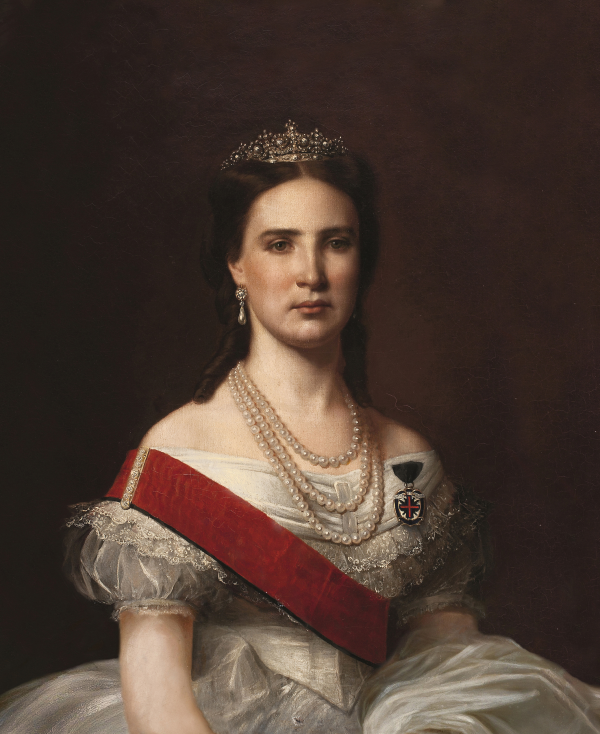 |
| Detail from Albert Grafle’s portrait of Charlotte of Belgium as Empress of Mexico, ca. 1860s (Wikimedia Commons) |
I’ve received numerous excited messages from readers about the recent royal jewel news out of Switzerland: the “discovery” of a suite of emerald and diamond jewelry that belonged to Princess Charlotte of Belgium, who is perhaps better known to history as Empress Carlota of Mexico.
 |
| Charlotte and Maxmilian in 1857, the year they married (Wikimedia Commons) |
The jewels come from the collection of Princess Charlotte of Belgium, the only daughter of King Leopold I of Belgium. (That makes her, of course, a first cousin of both Queen Victoria and Prince Albert; she was named for her father’s first wife, the tragic Princess Charlotte of Wales.) She became first Archduchess Charlotte of Austria and then Empress Carlota of Mexico during her marriage to Archduke Maximilian, the younger brother of Emperor Franz Josef of Austria. The couple married in 1857, and less than a decade later, Emperor Napoleon III decided to tap Maximilian to become the first Emperor of Mexico. (Long story very short: the French had invaded Mexico in 1861, and they wanted to make the nation a sort of French North American satellite state, with the country remaining under French control via Maximilian.)
 |
| The newly-rediscovered parure: (clockwise from top left) hair comb, tiara (upside down), necklace, and brooch (SKKG) |
According to the Stiftung für Kunst, Kultur und Geschichte (SKKG), the jewelry set was a gift to Charlotte from Maximilian. The suite as presently composed consists of four coordinating pieces: a tiara (or diadem) with a matching hair comb, meant to be worn together as a set; a necklace; and a large brooch. The SKKG writes that the “89 emeralds alone weigh 400 carats.” The entire parure features design elements typical of the Second Empire period. The SKKG notes that the tiara is particularly grand, possibly as a way to underline “the empress’s claim to power.” They also suggest that the choice of emeralds wasn’t a random one, as the color is a prominent part of the Mexican tricolor flag.
 |
| Santiago Rebull’s portrait of Empress Carlota, 1867 (Wikimedia Commons) |
Charlotte may have worn the set even before she set off for Mexico. In her 2014 biography of Maximilian and Charlotte, M.M. McAllen notes that the couple “were received with the highest state of honors and given an opulent reception and dinner at the imperial palace of the Hofburg” in Vienna before traveling to Mexico. She writes that “Carlota wore a diamond and emerald tiara designed for her new rank in Mexico” at that dinner. The jewels may have gained even greater significance once the couple arrived in Mexico. According to their article, the SKKG believes that the new Empress Carlota may have worn the parure for her coronation in Mexico City in 1864. Unfortunately, despite these glittering references, I haven’t found a photograph or painting of Charlotte wearing the emerald parure.
 |
| Albert Grafle’s portrait of Charlotte of Belgium as Empress of Mexico, ca. 1860s (Wikimedia Commons) |
Maximilian and Charlotte’s reign in Mexico was both brief and disastrous. The French were still battling Republican forces all over the country, and by 1866, they packed up their military might and headed back to Europe. Charlotte too headed back to Europe, hoping to drum up support for her husband. (She packed her jewelry in her luggage.) Napoleon III reportedly tried to convince Maxmilian to evacuate as well, but he refused, and he was captured and executed.
 |
| Charlotte as Empress of Mexico (Wikimedia Commons) |
After Maximilian’s death, Charlotte was understandably depressed and anxious, constantly afraid that she was being targeted by people who also wanted to hurt her. Psychiatrists reportedly treated her for a nervous breakdown. She lived out the rest of her life in Italy and Belgium, eventually residing in solitude at Bouchout Castle. She died there in 1927.
 |
| Charlotte, photographed in Italy ca. 1866 (Wikimedia Commons) |
Exactly what happened to the emerald suite immediately after Charlotte’s death is unclear, but in November 1978, the set was sold at a Swiss auction house. The buyer was an eccentric collector, Bruno Stefanini. The jewels remained in his possession until his death in December 2018, and they were recently rediscovered during an inventory of his immense estate. The jewels remain a part of his foundation, the Stiftung für Kunst, Kultur und Geschichte, and I’m hopeful they’ll eventually be put on display to the public.
Leave a Reply